

Anish Bhattacharya - NanoJapan 2015
University of Illinois, Urbana-Champaign
Major: Electrical Engineering
Class Standing: Freshman
Anticipated Graduation: May 2019
NanoJapan Research Lab: Prof. Yukio Kawano, Tokyo Institute of Technology
NanoJapan Research Project: ![]()
Why NanoJapan?
The NanoJapan Program offers undergraduates the chance to participate in international research in an exciting new field. I want to pursue graduate studies and conduct meaningful research in the future, and I know that NanoJapan is an integral step towards that goal. I think it is very important and helpful for researchers — and students like myself — to have international experience and contacts in order to collaborate on a wide scale. In this way, impactful research can be done. In addition, I feel that it gives us global awareness that can further enhance our ability to understand other cultures and mindsets.
I personally know people who are Japanese or have close ties to Japanese culture, and through them I have learned about the people and traditions. Japan has always been somewhere I have longed to go, and NanoJapan gives me the chance of combining this with something else I am passionate about — research. Through this program, I hope to not only learn about t erahertz devices and nanotechnology, but also gain first - hand experience about the culture, people, and of course, the food!
My goals for this summer are to:
I think it would be fit to say I have thoroughly enjoyed this past week in Japan. Most of the time we have spent in Tokyo, either exploring the massive city or going to language class every day and attending cultural and nanoscience seminars. To experience the sights and culture of Japan, we have attended Sumo and visited shrines.
One of the first things that came to mind when walking around Tokyo was how clean of a city it is. This makes the city seem more welcoming and easy to adapt to. However, this also causes a particular problem—there is a serious lack of trash cans. I suppose that Tokyo is such a clean city since the people here probably take care of their trash entirely on their own. It also makes sense that since Japanese people are generally more concerned with outward appearance and aesthetics, having garbage cans on the sidewalks would not be favorable. However, it makes things slightly inconvenient at times.
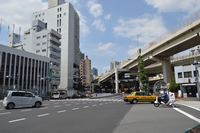
Near Azabu-juban Station
But the lack of garbage cans is a trivial matter when considering the incredible cleanliness of Tokyo. I thought that considering the population density of one of the largest metropolitan areas in the world, it would be difficult—if not impractical—to maintain such a high level of sanitation. I find that Tokyo is altogether cleaner than even some large American cities. This sort of purity extends to the air and water as well. There is not a cloud of smog over Tokyo as some Chinese and American cities are famous for. In addition, the tap water is entirely safe to drink. In fact, the water tastes great. It tastes just like, if not better than, the water I get where I live in Southern Illinois. This is especially refreshing after having returned from Kolkata, India in January, where bottled water is mandatory and sanitation on the streets is a serious problem.
Last Wednesday we attended Sumo. I am sure most people have some idea of Sumo wrestling, but it is probably a fairly skewed one. Actually attending the event was amazing. We were there for some three hours, and it never got even remotely close to boring or repetitive. In fact, we were getting very involved in the spirit of the huge stadium. Ajay, Cole, Dylan and I even managed to get some people around us cheering together for some of the wrestlers (one was named Endo, who seemed to be a crowd favorite). Of course, we had absolutely no idea who to cheer for so our choices were entirely arbitrary. Even if we weren’t actively cheering for a specific wrestler (go West side!) it was incredible to watch these people dodge, slap, push, hug, trip, and tackle to get the opponent to step outside the ring. Often the wrestlers were pushed outside the ring with such force that they fell onto the nearby judges or sponsors. In addition, it was interesting to observe the rituals that go into this traditional sport. Packard-sensei also provided explanations that helped us understand the different things that were going on, such as throwing salt into the ring or the wrestlers raising their arms and legs in ritualistic motions.
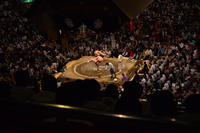
Sumo: Sumo wrestlers performing ritualistic movements
We have all really enjoyed the language classes as well. They are very intensive, as promised, but they are also entirely doable and very well run. I think that the way in which we are learning the Japanese language is very good; visual aids, conversational exercises, and a focus on phrases, are just a few aspects of the AJALT classes. I think that the fact that we are split into smaller groups is also very beneficial to our learning at such a fast pace. There is a solid connection between us (gakusei) and the teacher (sensei). The senseis are extremely helpful and enthusiastic about helping us understand the language. Every day I look forward to the next day’s class!
At this point we have also visited Nagano, which was absolutely incredible. I’ll talk about that in next week’s entry. My question for this week is: how can Tokyo manage to stay so clean if there is a lack of public trash cans?
NanoJapan Tip: Here is a good blog post on garbage disposal in Japan but also keep in mind this a security precaution. Public trash bins were removed from Tokyo, especially in subway stations, following a 1995 sarin gas attack by a religious cult.
Intro to Nanoscience Seminar
I really enjoyed the Introduction to Nanoscience lectures. Professor Stanton talked about the research of nanoscience right now, with a focus on nanomaterials and devices. It was really interesting and helpful to get the general overview of some of the materials we will be working on. The review of the basics commonly covered in a modern physics course was helpful since many of us took the course a while back. Saito-sensei’s lecture on carbon nanotubes (CNT’s) was particularly helpful since I expect to be working with them in the lab. Ishioka-sensei’s lecture was also very interesting since she spent some of the time giving us an insight into the world of a female scientist in Japan. I think a lot of the NanoJapan students, including myself, would like to have a copy of Professor Stanton’s PowerPoint presentation, if possible. It would be very valuable to us for continuing to review the basic concepts some more.
Initial Research Project Overview
I don’t know that much about my project yet. Daichi-san, my graduate student mentor, has told me that I will be looking at the terahertz response of single-walled carbon nanotubes (SWNT’s). I have been reading some material on (aligned) SWNT’s as well as on terahertz signals. I’m trying to be as informed as possible before entering Kawano-sensei’s lab.
The material I’m working with is carbon nanotubes, which is very basically graphene rolled into a cylindrical shape. It’s a semiconductor material, and can be thought of as a 1D material since the length-to-diameter ratios of these CNT’s are very high. I don’t know what properties I will primarily be studying. Neither do I know the experimental methods I’ll be using to conduct the research. This material has a very wide range of applications. It is thought that electrical devices using carbon nanotubes can be faster and more energy efficient. CNT’s are also very strong but their mechanical properties are not the focus of my research.
The past weekend was absolutely incredible. We all went to Nagano and spent the weekend working a rice paddy, playing Taiko drums, having a barbecue, and making soba noodles. And better yet, we were able to enjoy these things with the KIP students we met the previous week.
On Friday we left for Nagano by our first ever shinkansen, or bullet train. This train is just as fast as it sounds, and we were able to reach our destination in just a couple hours. While on the train we eventually were able to see more and more of Japan’s great natural beauty as the large metropolitan region faded away. We were surrounded by densely forested mountains, with snow-capped peaks visible in the far distance. As we rode the skinkansen, we passed in and out of tunnels as we travelled through mountains. Once we arrived at Ueda Station, we were exposed to a full 360 degree view of the landscape. We had escaped the largest metropolis in the world and were placed in the town of Ueda, a town surrounded by hills, valleys, forests, small rivers, and mountains.
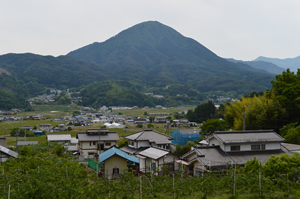
The town of Ueda
After having a ramen lunch, we boarded the bus with someone who very quickly became one of our favorite people: Jeo. Over the course of the next couple days he told us more and more of his life story. He was born in Columbia where he lived for a while, then he lived in the USA, then eventually moved here to Japan where he started raising a family. He told us about the local region as well, and since he had lived in the USA for a long time, he was able to tell us things from an American perspective, which was helpful at times.
We drove up the mountainside, through the thick forest. The road was so steep I was surprised the bus didn’t give up and roll back down the road. On the way back down, I was even more surprised that the brakes didn’t burn out. As we drove up the mountain, through the woods we could see engraved stones and statues. We stopped in a parking lot and walked to a very old Shinto shrine. Here, we performed a traditional praying ritual: approach the temple, ring a hanging bell, toss money into the collector (convenient donations), bow twice, clap twice, pray, and bow once more. After this, we ventured on a beaten path through the woods. Quite literally hundreds upon hundreds of small statues lined the path. Packard-sensei and one of the locals who helped organize our trip explained that they were all different kamis, or spirits from the Shinto religion. It was really interesting to see these statues so deep in nature, as if they were one with the trees, shrubs, algae and rocks. After exploring the path, we left to go try our hand at planting Asia’s staple food: rice.
Planting rice was definitely an experience. We were hosted by a very kind and generous older couple who treated us to some Japanese home-made snacks. We then took off our shoes and stepped into the deep mud of the rice paddy. It didn’t seem that difficult, but I think it’s safe to assume that is so because I was doing it wrong. After we cleaned off, we got to feed some of the livestock they had (a pony, sheep, and goat) and then we headed back.
We were staying in a ryokan that night, so we all go into the onsen to relax. The scenery around us—the mountains, Ueda extending below us down the side of the mountain, and the perfect weather—was perfect. Next on our schedule was to go taiko drumming. We were surprised that the kids performing for us were between the ages of 8-17, considering not only the massive power of these drums but the majestic strength and demonstration of the players. Every beat of each drum seemed like the heartbeat of a mountain. Watching them perform for us, beating the drums, yelling beats, and moving dramatically with the music was sufficiently awesome for us. It really cannot be described in words. But then they encouraged us to come learn how to play the drums with them. It was a lot of fun!
The next day we went to the Shinshu University campus. This was interesting because it was our first time on a university campus here. I don’t really know what I was expecting, but it was very similar to some American campuses, albeit smaller. We had a very interesting discussion with the KIP Japanese students on the use of smartphones in university lectures. There were a lot of good points. Having the discussion with students here gives another perspective to the debate as well. In the past couple discussions we have had, I have found that discussing issues with the KIP students is more interesting than discussing it in the (partial)echo chamber of just American students. In the evening, we attended a barbecue put together for us by Jeo and some of the other organizers. It was a festive, interesting, and altogether awesome evening. The food was delicious and the bonfire was truly a monster.
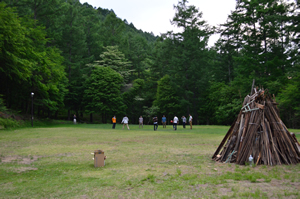
Pre-BBQ: NanoJapan and KIP students playing with a soccer ball
The following day was our last day in Nagano, and we spent part of it learning how to make soba noodles. Although our noodles were pretty misshapen, learning about the whole process made me appreciate the care that goes into the food. No doubt soba noodles are made in bulk with machines, but much of it is produced by farmers and local small business owners. The entire process is strenuous and very careful.
Intro to NanoScience lectures
As last week, the lectures have been not only very interesting but also useful in terms of information we will probably be utilizing a lot in the lab. Kono-sensei discussed a number of topics, ranging from semiconductor band gaps to carbon nanotube chirality. Tonouchi-sensei talked specifically about the THz regime and why it is so interesting. This was also particularly useful since I will be working with THz signals in my research. The lecture helped give me more perspective in my pre-lab research.
Preparation for Research Internships -
Summary of Kawano Lab paper
This specific paper, “Carbon Nanotube Terahertz Detector”, focused on exploring the creation and analysis of a terahertz optical signal detector made from single-walled carbon nanotubes. It was also contributed to by the 2013 NanoJapan participant Jennifer Lloyd.
X. He, N. Fujimura, J.M. Lloyd, K.J. Erickson, A.A. Talin, Q. Zhang, W. Gao, Q. Jiang, Y. Kawano, R.H. Hauge, F. Léonard and J. Kono. "Carbon Nanotube Terahertz Detector", Nano Letters, (2014) DOI: 10.1021/nl5012678.
The paper starts by summarizing some basic properties of CNTs: they can absorb a large range of radiation by doing so via intraband (free carrier) and interband (excitonic) absorption processes. It has been shown in other studies that many forms of metallic SWNTs at low temperatures can detect (react to) THz signals. This paper specifically reports results from a detector that operates at room temperature.
The SWNTs were grown on a silicon substrate that was prepared with microlines of double-layer catalysts (Fe/Al2O3). The CNTs were vertically grown on the substrate via chemical vapor deposition. They were then transferred to either a Teflon tape or AIN substrate to form horizontally-aligned films. The CNTs were oriented perpendicular to the direction of current flow across the sample. Half of the sample was then n-doped with benzyl viologen to create a p-n junction on the CNT film. Gold was used to make the two electrodes (via electron-beam evaporation). The terahertz signals used were 1.39, 2.52, and 3.11 THz. The laser beam was linearly polarized, then reflected and focused by off-axis parabolic mirror onto the p-n junction of the sample.
The I-V (current-voltage) relationship of the sample was measured with and without the incident THz beam. The relationship was linear, as expected, and shifted left when the signal was turned on. The open-circuit voltage decreased and the short-circuit current increased. It was also found that the photovoltage increased when the polarization of the incident THz beam was at a low relative angle compared to the alignment of the CNTs. When the relative angle was highest (90 degrees) the photovoltage was suppressed by as much as ~82%. The photovoltage also increased linearly with increase in incident laser power.
Thermoelectric response of the THz detector was also measured to compare to the THz response. A thermal gradient was applied across the sample, and the resultant voltage was measured. In short, there was a response comparable in magnitude to the THz response. This response was the sum of the separate responses of the p- and n-type doped parts of the CNT film. The significant response implies that optical generation of electron-hole pairs is not necessary to generate a photocurrent in these devices.
This study “developed a room-temperature CNT p-n junction THz detector that is powerless, compact, broadband, flexible, large-area, and polarization sensitive”. This is a very impactful feat since most THz detectors today operate only at low temperatures, are large, and are expensive. The creation and subsequent analysis of this CNT p-n junction THz detector opens a new door to THz research.
Recently we have been using public transportation a lot—specifically the subway, or chikatetsu. When living among such a massive population of people in one of the world’s largest cities, I have tended to notice certain similarities and differences to experiences I have had in American cities. Specifically in the subway, people in Japan are definitely a lot more detached from the people around them. This is evident through a few ways, but it is most apparent by the way nearly everyone seems to be staring down at his/her feet. The entire ride. Looking down. Quick glance up to check the station, then right back down.
Honestly speaking, the majority of them are staring down at an iPhone/Sony phone, iPad, book, or even PSP, but I have noticed that even in America’s subways there is a great deal more eye contact between passengers. And if it wasn’t evident already, someone could instantly identify me as a tourist just by the way my eyes wondered around, curiously looking at the people and scenery outside the car. I could quite literally stare at someone sitting across from me the entire subway ride until they got off and they would not notice because they would never look up. I was sitting next to a woman once on the subway who had a hat that covered the top 75% of her face—only her mouth and chin was visible. As any respectable person would have done, I snapped a selfie with her and she was none the wiser.
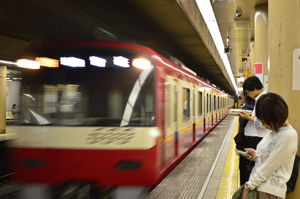
Of course, being in Tokyo, the subway stations and cars can get very crowded. I have never ridden the metro during prime-time rush hour (similar times as in the US), but I definitely want to venture to the station at that time merely to witness the miracle of the masses of people being jammed into each subway car. A little past prime-time, around 7 pm, it is still fairly crowded, common to what an American subway would be like near 5 pm. This is when the common rules of the Japanese subway emerge (although they may be similar in the US, honestly I don’t know). At every single gate to the subway, two lines form on both sides of the entrance, leaving the middle region clear for people disembarking the car. This happens like clockwork—even children travelling by themselves obey this.
I just got to Hiyoshi a couple days ago, where I will be living during the research internship period. The place is really nice, with a shopping/food district next to the station and a huge supermarket in the station itself. There are no other NanoJapan students working at Tokyo Institute of Technology with me, so it can be pretty daunting sometimes doing everything by myself. While in Azabu-juuban I always had thirteen others (plus KIP students) as back-up, but here I go it alone. Which brings me to an incident at my student-house. This morning I had gone down to have breakfast, which is provided here under the meal plan. As I tried to swipe my card, it would not work, so someone who works at the cafeteria came to help me. As she helped me and walked me through the process (she didn't speak English), I tried to interject some of my learned Japanese here and there into the interaction. I was met with chuckles from her as well as straight up laughter from another worker nearby. That is not what I expected at all.
Especially since I am now living on my own here, it probably hit home harder than it would have during the past few weeks with the other students. Honestly though, I probably should learn to expect this every once in a while. I am a foreigner in this country, and communicating with people in this new language will be a struggle.
Research Internship Update
Now that I have recently entered the lab, I have started to learn more about my project. Currently my only task is to study some more about my topic. I have basically been reading papers and taking notes on them. Occasionally I discuss my project with my mentor, Daichi-san. Unfortunately, prior to my arrival the electron-beam evaporation machine broke. This machine is used to deposit metal electrodes onto a given sample. Although this put a temporary halt to the progress of experimentation, there are other things I can do until the machine is fixed.
The Intro to Nanoscience lectures were very helpful and interesting this week. In addition to the typical lectures, we were talked to by the Head of the Tokyo Office of the NSF. A lot of us are interested in opportunities of coming back to Japan in the future, so it was nice to listen to her describe the programs the NSF supports for graduate research in Japan. This week we also got to visit Elionix, a Japan-based company that designs and manufactures machines used in nanoscience research. This is a rapidly growing company that is integral to much of the research being done not only in Japan, but in other places around the world. It was really interesting to see this side of the process since many of us are used to only seeing the machines in a research setting, already being used. Dr. John Bird’s lectures were also very helpful this week. Although we picked up a lot of the basics from the earlier talks, Dr. Bird’s lectures helped fill in the gaps in our understanding of basic concepts and introduced us to new ideas we had not heard about.
As I mentioned in Week 3’s report, I have now come to live in Hiyoshi and work at Tokyo Institute of Technology. My mentor, Daichi-san, has been incredibly helpful and nice throughout my transition here and my first week at the lab. He met me at Hiyoshi station, where he took me to the Tokyo student-house where I would be living. He talked to the front desk and arranged everything for me, then took me to my room and explained everything; he even described to me how the AC works! I could not ask for a more helpful mentor. Although Daichi-san’s English is not perfect, it is very comprehensive and completely understandable. The only difficulty he has occasionally is finding the right vocabulary to describe something, but I can usually help him find the right words. After helping me get settled, he took me to lunch where I got to know him better.
My first day at the lab was pretty interesting. I was in no way prepared for the amount of people working at the lab. In total, I would estimate that around 35 students (Master students and PhD candidates, mostly) work under the two professors, Oda-sensei and Kawano-sensei, which basically means I didn’t bring enough gifts. This aside however, Daichi-san helped introduce me to everyone and I was given a very warm and nice welcome. Everyone here is really nice and most of them know a fair amount of conversational English. Although speaking Japanese here is not really necessary, I occasionally say some things in basic Japanese. My interjections of Japanese never fail to astonish my lab mates. Friday was the day of my welcome party. By the time I was brought to the room, the tables in the conference room had all been moved to the side, apart from those holding pizza and sushi (and drinks, of course). It was a great time to get to know everybody.
One thing I was delighted to find is that the view from my cubicle in the students’ office room is amazing. The campus of Tokyo Institute of Technology is already elevated, and being on the 8th floor of the building helps to the extent that when it sunny and clear, Mt. Fuji (Fujisan) is plainly visible. It is amazing to see the city of Tokyo in the foreground with Fujisan majestically towering over. Someday next week I will bring my camera to snap some pictures, since there are views from all around the building and even from the 9th floor.
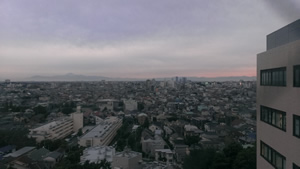
A picture I took with my phone’s camera. Fujisan can be seen on the left!
During this first week at the research lab, one of my objectives was to adjust to the new people and environment. My second goal was to become as knowledgeable as possible about my research topic. I had already read a lot about carbon nanotubes, THz detectors, and CNT transistors, but I was given more material by Daichi-san. This week I spent poring over papers, accumulating information about THz time-domain spectroscopy, photovoltaic responses of aligned SWNTs, and other topics I would likely refer to in the upcoming weeks of research. NanoJapan students must make do with the few weeks we are given with research teams in these laboratories. I hope to make the most of my time here. Next week I should be able to begin taking measurements using a sample of highly aligned SWNTs given to me by Kono-sensei. I will also be helping Daichi-san make measurements with his samples, so I can learn more about his research and the methods and apparatus used in the laboratory.
Assessment of Orientation Program and Language Classes
The orientation program was nothing short of very enjoyable, helpful, and amazing. There are so many aspects to the orientation program that it is, in fact, difficult to begin discussing it. The Intro to Nanoscience lectures were incredibly helpful in teaching us the basics of what kinds of materials we will be working with. It also filled in the gaps of our understanding, and every lecture managed to build more on what we had learned in the previous one. In my previous weekly reports I also talk about these lectures. The cultural lectures (including the discussion with Nancy Snow) were very interesting. Because of the discussion/seminar format, they allowed us to openly discuss things we had observed on the streets of Azabu-juuban. Specifically, we got some insight into the contrast between traditional Japan and some of the modern culture, as well.
Interacting with the KIP students was possibly the best aspect of the Orientation Program. They, very basically, are our Japanese counterparts—students our age who have a mind for international collaboration. By talking to them, going on trips with them, even karaoke-ing with them, we got to see Japan from another perspective. This leads me into the trips we took to Nagano and Kamakura. Nagano was a great experience (described in a previous weekly report), and experiencing it with the KIP students made it even better. The Kamakura trip was entirely put together by the KIP students for us, and it was amazing to see the shrines and temples there.
I never would have imagined how much I could learn of a language in just three weeks. Obviously, we all have just merely learned the basics and have just barely scraped the surface of Japanese. This is why most of us plan to continue learning independently, by studying the materials we were given as well as by dissecting children’s’ books! The language classes were beyond beneficial, and they wouldn’t have been the same if the senseis hadn’t been so kind and encouraging.
The most important thing I have come to learn about in Japan is no doubt the culture. But specifically, I most value the time I have spent with the KIP students. I have learned so much from them simply because they are other college students, my age, who can give me their perspective about all the issues we have discussed.
NanoJapan Research Project Update
In this first week I have focused on adapting to this new environment and getting situated, as well as reading papers and preparing for the next week of measurements. The next step is to use THz time-domain spectroscopy to get information about the THz transmittance of the sample that Kono-sensei gave me. In addition, I am to continue work on the THz detectors that were previously worked on my other NanoJapan students. I hope to extend the study on these to wider temperature ranges, etc…
I am being taught by Daichi-san how to use the different equipment available in the lab. The simplest machine would probably be the vacuum that Daichi-san stores his samples in. I am also going to use the new THz-TDS machine. This is in addition to the IR and THz lasers and cryostat.
I am not completely sure on my definite project since I will be working on my sample as well as the THz detectors already fabricated. I will soon be working on putting together a timeline for my project. Since I have less than two months to work here, I will be discussing this with Daichi-san as soon as possible.
Instead of analyzing a specific incident where I had to deal with cross-cultural interactions or misunderstanding, I will reflect on this past Sunday as a whole. For the past week, the Tokyo/Chiba NanoJapan students and I were all planning to go to Nikko on Sunday. They were also planning to get together that Saturday night to play cards and meet with some of the KIP students. Unfortunately I could not attend that night because I had already committed to go to Oda-sensei’s annual Summer Party. It was being held at the bay-side Zushi Marina Resort—how could I say no? The other NanoJapan students had decided that night to not go to Nikko the next morning because they were fairly exhausted. Regrettably, I never got this information and so I left at 6 in the morning to start my 3-hour long journey on the subways.
Of course, once I got to Nikko I soon realized I was alone without my cronies to help me out in an incident of cross-cultural miscommunication (hint, hint). It was safe to say that I was fairly annoyed when I realized I was there by myself without much idea of what even our sightseeing plans were. Since I knew nearly nothing other than a couple tourist location names, this meant I had to talk to a travel agent. Luckily, they knew some English. However, the one I spoke to spoke only very broken English. I had to discuss bus schedules and map routes, so you can imagine the difficulty that ensued. However, I tried my best to use Japanese whenever I could, and throughout this entire trip I realized just how invaluable those intensive language classes really were.
We each tried to use our non-native language as much as possible to help each other understand what we were trying to communicate. There was a lot of gesturing involved in the sense of pointing, but also some hand-waving and a lot of head-shaking. Ultimately, however, I managed to get my points across about the different places I wanted to see (as I said, I only knew the names) and he indicated which bus pass I should purchase and what map I should take. I then proceeded on my way to find the correct bus to board and be on my way to the World Heritage Site with the famous Toshogu Shrine (and many others).
It started raining, which really exasperated me since I was trying to take pictures with my camera while holding my camera bag, the souvenirs I had bought, and my maps. I managed to purchase an umbrella—honestly, mainly to keep my camera from getting wet—and at that store I needed to ask for directions to the famous Skinyo Bridge. As would happen many other times that day, it was apparently “just around the corner”. Whenever I was told this, it perplexed me even more because it evidently was not that close. However, using my beginner Japanese I attempted to glean some more information from the store clerk and I got pointed in the right direction. It was evident that even though I may be in a trying situation, in order to communicate as clearly and efficiently as possible I have to keep a cool and open mind. Because although the store clerk said some things that were confusing to me, she still managed to help me a lot.
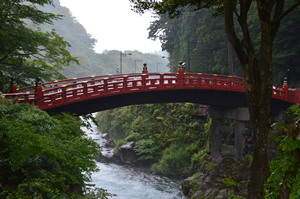
I then went on to the second part of my day at Lake Chuzenji. It was a really cloudy day and given the weather, the clouds did not allow you to see across the enormous lake or even see it in its full beauty. I talked to another travel agent at the tourist information center there. She gave me some tough news: I wouldn’t be able to see the famous Kegon Falls because it was so cloudy. It was difficult to stomach this information since that was my main attraction for going so far to Nikko. I went to see Ryuzu Falls and when I came back, I decided to go to Kegon Falls anyway if by chance I could see any of it. Lo and behold, the clouds had parted slightly and for a few minutes I could see the amazing falls! What struck me though was its extremely close proximity to the information center where I had been told I shouldn’t go to see it due to the weather. It seemed odd that she suggested against it even though it would have been just a 3-minute walk to check. I feel like there was some key miscommunication in the transaction where some part of the information or suggestions was lost. She spoke very broken English as well, and I think the language barrier and maybe the cultural tendency to not want to give misleading or incorrect information definitely skewed the perceived meaning of her advice.
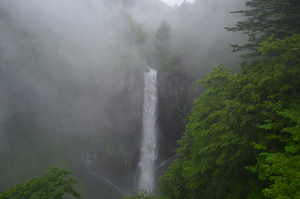
NanoJapan Research Project Update
Last Monday Daichi-san and I worked on characterizing my aligned-SWNT sample through THz time domain spectroscopy. Before doing the measurements I had studied the mechanisms of this technique and had understood it. Our lab recently got a new, desktop-sized machine specially made for THz-TDS so it took a little time for us to figure out how to setup the sample and emitter/detector. We didn’t use a purged or otherwise very controlled environment; we were merely trying to get some basic measurements on the THz transmittance of the sample. In addition, we rotated the sample to examine the polarization sensitivity. Data was taken with a Si reference substrate, the Si substrate on the sample chip, the CNTs oriented one way, and then the CNTs rotated 90 degrees.
We used Microsoft Excel to roughly examine the data. We discussed the results with Kawano-sensei and they decided that we should send my sample to another laboratory that will return precise data to us. Meanwhile, I will work on gathering additional data on previously-fabricated CNT THz detectors.
This week I mostly learned about the different instruments in the lab and I helped Daichi-san with his measurement-taking for his research. There were some issues with the cryostat (the windows of each shell were not aligned) and I helped another lab mate take the cryostat apart and fix the issue. By helping Daichi-san with his measurements, I learned how to operate the whole IR laser-cryostat-multimeter-computer network. His work consists of studying the infrared-response of an organic material. There are electrodes on an organic substrate to which he applies a voltage bias and analyzes the current response. We varied temperature (and pressure) to analyze the resulting I-V responses.
I talked to Daichi-san a lot about my research for the next few weeks. Although I have yet to start work on it, I know it is to do with the characterization of wafer-scale films of aligned SWNTs for use in THz room temperature detectors.
In my time in Japan, especially after coming to live by myself in Hiyoshi, there have definitely been a few tough times. These instances range from struggling with the language barrier to adjusting myself to a new daily routine. The situation that stands out without a doubt as very challenging would have to be my day trip to Nikko, part of which I described in detail in Week 5’s Report. After being dropped in an environment that I was utterly unprepared for, going about my day as a tourist from a foreign country was something I won’t easily forget—not that I would want to. That day put me completely out of my comfort zone and forced me to build my experience almost completely from scratch. The fact that I ended up seeing some amazing sights by the end of the day, I feel, justifies my efforts and has given me a newfound courage to explore a little more while I am here.
I realize that in the past week another personal accomplishment resides in my venture to buy a wireless mouse. While working at lab I thought that a mouse for my laptop could be of some use, so I looked up some nearby electronics stores and prepared a battle plan for where to look and how to get there. The specific store I wanted to go to was a Yamada Denki only a 5-minute walk from a subway station on the way home. After leaving lab I headed for the correct station, and once I exited the station I found a complex intersection (or should I say chaotic mess) of streets. Since I merely had a grainy photo of Google Maps to look at on my Piccell phone, distinguishing streets was near impossible. I was not really prepared for this since in the past I had always been able to navigate based on the street angles and intersections. I wound up walking around for a solid 45 minutes—at least—trying to find one of the two restaurants listed on my phone in English to use as landmarks. After these 45 minutes I came back to the station, ready to give up and head home. I gave one last desperate glance to my phone and realized that the name “-zuho” on my phone’s picture of Maps was cut off by the edge of the screen. I had remembered passing the bank Mizuho walking around the area, so acting on the hunch I backtracked to where I remembered it was. I oriented myself with the map and the streets seemed to agree with my picture! I proceeded to navigate meticulously through the streets, matching kanji shop names to my picture. Eventually I managed to find my way to Yamada Denki.
Other than these instances, I don’t think there are any things that have caused troubles in my stay here. I generally am really interested in experiencing different, and even “strange”, things. So immersing myself in the culture and cuisine hasn’t been difficult at all. My experience in being abroad (including my trips to India, of course) have probably made this easier for me than it may be for other NanoJapan students.
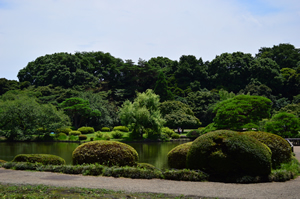
Here is a view from my Sunday trip to Shinjuku Gyoen, a large landscape garden in central Tokyo.
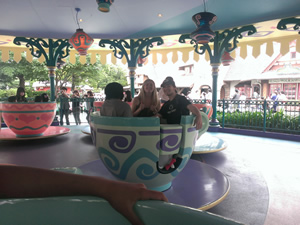
On Saturday Rocco, Katherine, Jacqueline, Brandi and I went to DisneyLand!
Research Project Update
My research, I feel, could be going a little faster than it is now. The major problem, however, is that many of the essential machines for my experiments are broken or under repair. Apparently the day before I arrived, the electron beam evaporator (EBE) broke down (but I just found out I can use it with limited functionality anyway). The terahertz laser has a window in it that isn’t allowing enough power to be transmitted, and therefore it is virtually unusable for any experiments. Additionally, the cryostat will be under repair in the 3rd week of July. Because I haven’t been able to do much towards my project so far, I have discussed possible timelines with Kawano-sensei and Daichi-san. We have decided that as soon as I come back (July 6) we will gather spatial THz response information with the scanning near-field optical microscope. We will also gather THz absorbance information via the new THz-TDS machine. Soon after we should be able to use the limited-functionality EBE to fabricate the device (plate Au electrodes). Hopefully the THz laser will be fully operational again and we can begin measurements before the cryostat goes under repair. If everything goes according to plan, which hopefully it does, the first couple weeks after I get back will be very busy.
This past week I continued to assist Daichi-san in some of his measurement taking. I also focused on compiling my presentation and putting together a project timeline, as mentioned above. Compiling the presentation helped me get a more solid idea on what my project is specifically trying to do. Hopefully in the upcoming month I can pick up the pace in the research.
Learning Japanese through the intensive AJALT classes was very enjoyable and effective for me. Of course, three weeks is not enough to become proficient in speaking Japanese, but I know I was leaps and bounds ahead of where I would be with just self-study. Some key things I learned in the classes include Japanese sentence structure, how to read kana, and some phrases that are engrained in the day-to-day culture of Japan. Without the language classes, I don’t think I would be nearly as successful living on my own. This has been made evident to me numerous times, including during my independent trip through Nikko, navigating the subway systems, and purchasing items in local shops. My most challenging language experience was definitely during my exploration of Nikko, which I have described in detail in previous reports. This experience in particular showed me just how priceless the language classes were, and it has inspired me to pursue independent study of the language.
Although I thought I would continue self-study immediately after the classes ended, research and travelling has taken a lot of time and I have only been able to study a handful of times. However, as a lot of other NanoJapan students feel, I would like to come back to Japan in the future whether it be for graduate studies or for more cultural immersion. In this case, studying the language would be very beneficial for me, and I think I have sufficient motivation to continue even once I get back to the USA. Although I plan to focus mainly on conversational/spoken Japanese, I may learn some common kanji to assist my understanding of the language (as Bird-sensei has suggested).
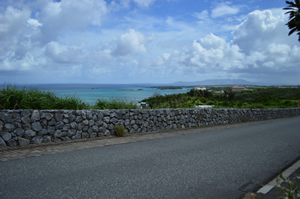
Looking off the coast of Okinawa. It was a sad goodbye.
The Mid-Program Meeting at Okinawa was both fun and informative. It was great to be reunited with the rest of the students and discuss our individual research experiences. Sharing our experiences helped us gain a greater understanding of the Japanese research lab because some of us have very different lab dynamics. The group discussion of research progress, timelines, and upcoming deadlines also cleared up a lot of the confusion surrounding what was to be expected of us by the end of our research time here. And of course, hearing about how past years’ students also had a bit of a panic regarding research completion made us a feel a little more at ease.
The MTSA Conference was incredibly interesting, and I really enjoyed sitting through the sessions we did (although I wish we had time to listen to some more of the other attending professors speak). Preparation leading up to my presentation helped solidify concepts about my project as I discussed details at length with my mentor, Daichi-san. Listening to my fellow NanoJapan students as well as other undergraduates describe their projects also gave me a more comprehensive idea of the terahertz-related research going on right now.
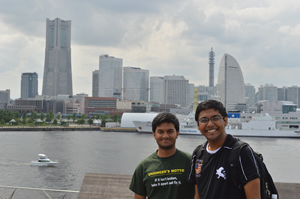
Ajay and I went to Yokohama on Tuesday. Here we are on Osanbashi Pier!
Research Update
Because we were waiting for the near-field scanning microscope (SNOM) to be introduced later in the week (when I was gone), there wasn’t much for me to do in lab this week. Therefore, I spent Monday in lab and spent Tuesday exploring Yokohama with Ajay.
On Monday, I gathered thermal noise data on previous THz detectors used by Fujimura-san. We used a system that included our device, a room-temperature/atmosphere mount, a current amplifier and lock-in amplifier. I will analyze some of this data next week.
I have worked in a couple university laboratories in the past, including one in biochemistry (genetics) and another in electrical engineering (acoustic sensing). These experiences allow me to now contrast my current laboratory experience to what I am used to in the USA. There are certainly many differences, although the setting and goals may be similar. One of the glaring differences is the respect that is shown in either laboratory. I don’t mean that in one lab more respect is shown to superiors, but rather that the way in which respect is shown is very different.
In a United States university laboratory, when discussing ideas students are—typically—free, and even encouraged, to counter what a superior may be suggesting. This is still seen as showing respect since it shows you are paying close attention and are willing to put forth your own ideas. Although the intentions of a Japanese laboratory are the same as those of a US counterpart, such interactive discussion with superiors isn’t commonly done. I have watched many of my lab mates talk to a professor about their research, and usually s/he never interrupts the professor to input his/her own ideas. Instead, it is likely that the student will write down the professor’s notions to study more later. This is especially noticeable during lab meetings, when a student is presenting on research and professors ask a question. I have noticed that the dialogue is largely one-way, even when communicating with an upper-classman. In some cases, I have talked to the students later; this is when I hear the perspectives the student has about the professor’s earlier comments. I feel like this one-way dialogue persisted in a US lab, the professor would go out of his/her way to encourage a more interactive discussion!
As we were told in the Pre-Departure discussions, Japanese honorifics may be used in the lab. For example, students of similar or older age may be referred to as –san, and younger students may be referred to as –kun. In my lab, these respectful suffixes are often forewent when talking amongst lab mates. For example, I am rarely ever referred to as Anish-kun (I hear my name come up in discussion quite often in the lab). However, when a sensei (professor) walks into the room, everyone refers to everyone else in a more respectful manner, and I become Anish-kun. The atmosphere of the whole room instantly changes to be more respectful. However, I have never experienced such an experience in a US lab. However, this isn’t to say that US labs are any less respectful; deference is simply shown in different ways.
The Pre-Departure discussions certainly helped prepare us for the cultural norms and typical laboratory rules in Japan. However, some of the things we were warned about are not necessarily as true anymore. For example, clothing restrictions are not very strict (unless you are working in a lab where clothing matters). Typically, people in my lab wear pants every day, no matter the heat outside (atsui desu ne!). But there is one lab mate who wears shorts every day. I have chosen to take after him and wear shorts as well. To confirm my choice, I asked Daichi-san about it and he gladly said I can wear whatever I want.
Altogether, I really enjoy working in this Japanese lab. But if I had to choose, I suppose I would prefer to work in a US lab setting. This is for reasons above, such as more freedom and openness of communication. In addition, I have noticed that Japanese labs (OIST being the exception) are not very diverse. Certainly this is a result of the strict immigration policies and the largely uniform Japanese society compared to the melting pot of the US populous. There are a few international students in every lab, but I feel that the great diversity of most US labs breaks down barriers of communication that are all too present in labs here.
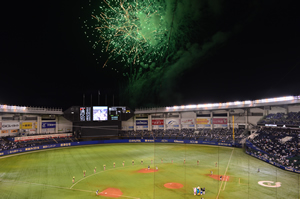
The baseball game the Tokyo/Chiba students, mentors and senseis, Kono-sensei, Dr. Matherly, and Sarah all attended!
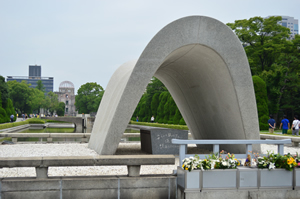
At the Hiroshima Peace Memorial Park. It is a very moving and beautiful place.
Research Update
This week was very productive. In the beginning of the week, I focused on analyzing the noise data gathered from the previous week with Fujimura-san (he worked with Chris last year). This noise data came from the CNT THz detectors previously used by Fujimura-san for room temperature/atmospheric conditions. I began by calculating the theoretical thermal noise of the device; I used the Johnson–Nyquist noise current equation (found in Wikipedia, of course). I then looked at the noise data gathered, taking into account the noise of the current amplifier we used as well as the sensitivity of the Lock-In Amplifier. The results were a little confusing, and Kawano-sensei suggested we use an oscilloscope to further analyze the noise of the device.
The lab visit was very helpful. Kono-sensei, Kawano-sensei, Daichi-san and I discussed the data gathered so far (THz-TDS) and the future plans for measurement-taking. It was most helpful because we planned out a progression of analyses to perform on my sample.
The THz-TDS data we took a couple weeks ago seems promising (we discussed it further with Kono-sensei as well). It shows a clear polarization dependence of the aligned CNT film in terms of polarized THz radiation transmitted. It can be seen that the perpendicularly-aligned test showed a transmittance hovering round 1. The parallel-aligned test shows significantly lower levels of transmittance; the CNT film absorbed much of the THz radiation. These numbers are the ratios of the transmitted power divided by the data from the on-chip silicon substrate.
A lot of time was spent taking data with the near-field scanning optical microscope (SNOM) over the course of three days this week. Because it is a new machine, we had to learn how to operate it first. One thing we had a lot of trouble with was controlling the noise level of the cantilever’s received signal. Hours were spent trying to tweak mirror focus and position to decrease the noise (and focus the THz beam better). Once we were satisfied with the noise levels, we took data across the edges of the CNT film as well as in the many breaks/cracks in the sample. Some strange things were noticed at times, like that the silicon substrate was absorbing more than expected. Maybe there is a very, very thin film of CNTs across the film cracks we were scanning across? We will take more SNOM measurements. In the figure, different levels of brightness indicate different levels of THz absorption (this data was taken at a very high THz frequency, close to IR). Figures on the top row show magnitude of power absorbed at different points on the sample, and the lower row holds data of varying phase of the received signal at the cantilever. Future data will be taken with hopefully less noise. Data was taken focusing on the polarization dependence of the absorption. However, more accurate polarization-dependent measurements need to be taken.
On Tuesday of next week we will visit Advantest to take some highly accurate polarization-sensitive THz-TDS data. After this, we plan to fabricate the device (deposit gold electrodes).
For this week’s report I interviewed my professor, Kawano-sensei, to get a better idea of his career path as well as the differences he perceives between a Japanese and US research lab. Talking to him about this was very interesting because he takes part in a lot of international collaboration that often requires him to travel to the USA. I believe that he is a researcher that truly has a global mindset towards scientific advancement and cooperation.
I began by asking him about his educational background. He told me that during his bachelor’s degree, he was inspired by the Nobel Prize awarded for the description of the Quantum Hall Effect. Because of it, he chose to study semiconductor physics and joined a laboratory in the subject. He also mentioned how he did his bachelor’s, master’s, and PhD in The University of Tokyo. Apparently it is common practice for Japanese students—who decide to pursue a career in academia—to stay in a single university for these degrees, whereas in the USA students are often encouraged to move to different universities for graduate studies.
Kawano-sensei also mentioned his experience in working in laboratories outside Japan. He has visited the US numerous times for conferences, work, and lab visits. The biggest difference he has noticed is the prevalence of the “pyramidal structure” hierarchy in the Japanese lab. Labs in the US, he says, place a large emphasis on individualism as well as group discussion. In his mind, the Western atmosphere is better for scientific thinking because of it. In his lab here at Tokyo Tech, he tries to merge the two styles together. We have group discussions about research progress and topics more than once a week, in which professors often try to encourage students to answer questions about their work. These practices are becoming more and more common in other labs in Japan, as is evident by reading the reports of other NanoJapan participants.
As mentioned in the previous paragraph, Kawano-sensei is very active internationally. He attends many conferences worldwide, as I can attest to, having been here only for a couple months. He also collaborates a lot with other researchers around the globe. After conferences he often makes an effort to meet professors and researchers, and visit some of their labs to learn more about what they are doing. He also takes part in seminars and general discussions. All of these activities are good for thinking and the exchange of ideas. He also mentioned that it is very important to be internationally active because Japan is a fairly isolated country. By reaching across borders, not only new ideas but also new styles of research can be shared.
One thing that Kawano-sensei said that stuck with me is that a lot of the Japanese students, even ones here in the lab with me, often strive to land an industrial position rather than continue research in academia. In the USA, according to him, more students stay in academic research for various reasons. Because this is a question I have pondered for my own career path, it was interesting to hear about his perception of the issue. I know that in my university, many students typically prefer to go into industry as soon as possible than strive for advanced graduate degrees. However, Kawano-sensei also said that in the USA, a PhD is more valuable because it can not only be helpful in academia but also in industry. In Japan, a PhD is typically restricted to academic careers.
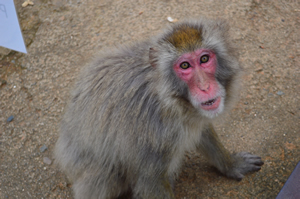
In Kyoto: we went to a place famous for monkeys! Note: don’t make eye contact, as seen in above picture. This guy got agitated and started to jump up towards my camera.
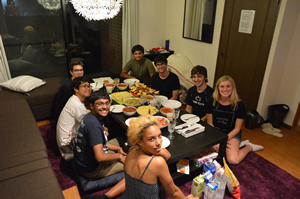
Kyoto #2: Food always tastes better when you make it yourself—and with friends!

Kyoto #3: On our last day there, we went to the absolutely massive Todaiji Temple, which houses a 49-feet-tall Buddha.
Research Project Update
We have been continuing to take data with the SNOM. It is still proving very difficult to decrease noise levels when taking the data. This is an issue when we want to analyze higher-order data. The higher-order data is useful because it can help to understand the characteristics of the CNT film only, while filtering out background data. One hypothesis for the excess noise is that the laser beam isn’t focusing as well as we would like. Fujimura-san and Daichi-san tried the THz laser (FIR + Co2 gas laser) and the quantum cascade laser but no better results were achieved.
This week we went to Advantest to use their THz-TDS machine. The machine we used there was just a variant of the new one we have. The only reason we are using theirs is that ours isn’t set up properly yet (no purged environment or proper chip holder). We used two machines, one of which accurately used radiation from 0.5 to 7 THz, and the other from 0.1 to 4 THz. We made use of both machines because although the first one had a wider range, the polarization of emitted radiation was not altogether precise (only ~80% was along a specific axis). The second machine had a narrower frequency range but had much higher precision when it came to radiation polarization. I analyzed the data using Advantest software on one of the common PCs. With it, I was able to isolate the single transmission response and cut out data picked up from reflections. There is a huge difference in THz absorbance between the parallel (CNT alignment parallel to incoming radiation polarization axis) and perpendicular cases.
We want to fabricate the device (deposit Au electrodes and mount on chip carrier) as soon as possible so we can start taking photothermoelectric measurements, but before doing so, we also want to try to get some more SNOM data. It is really important to understand how the sample behaves across the film, and especially across the many fissures and edges. We continued to take data, even though we were getting high levels of noise.
On Friday, we finally began the fabrication process. First, we cut the sample so some was left for future study, such as SNOM measurements, and so it fits on a chip carrier. We then created a mask out of aluminum foil that had holes where we wanted gold to be deposited for the electrodes. After analyzing the sample and mask under an optical microscope, we placed it in the electron beam evaporation machine (EBE). However, the machine was out of gold, so we will have to continue the fabrication process next week.
In the United States, gender roles are a common topic of debate. It is widely expressed that women should be able to have the same jobs, with the same pay, and with the same respect of their male counterparts. In Japan, whether similar contentions are felt or not, women tend to play a backseat role in terms of prestigious jobs and respect. However, many of the country’s leaders, including Prime Minister Abe, are actively trying to change this. Part of Abe’s plans includes something called “womenomics”, a theory that the economy of Japan would greatly improve if women were given more attention and took a more active role in the market (jobs and spending). A similar push for the increased role of Japanese women comes in the world of STEM—science, technology, engineering, and mathematics. In universities across Japan, women make up more than 60% of the humanities departments’ student bodies. In engineering and other science-related fields, this statistic drops to less than 15%. Women in science, according to many female students, still holds a somewhat less attractive stigma than does women in the arts.
I have also observed this in my own lab here at TITech, although markedly only with the native Japanese women and not with the international students. In comparison to the men in the lab, the women tend to be much quieter and held back. This is especially evident in group discussions or meetings, where the women are noticeably less assertive when responding to a question or in the discussion (although in general, Japanese students tend to be much less emphatic than students in the US). In addition, the sheer lack of female students in my lab is hard to miss. In the room where I work, there are a total of 19 other students, only 1 of which is a girl.
This stigma against women in science was challenged, however, when researcher Haruko Obokata discovered a breakthrough method of developing stem cells. At the time, she was a junior researcher at the RIKEN Center for Developmental Biology at Kobe. While working under supervising senior researchers, she found that physical stressing of embryonic cells makes them pluripotent, or able to turn into the cells of any—or most—tissue type in the body. This was a huge step forward not only for the understanding of nuclear reprogramming of cells, but also for women across the country. The stereotype of only men in Japan succeeding in pure science research is becoming a thing of the past.
However, after months of attempts, peer researchers failed at replicating the results of her ground-breaking paper. One of the co-authors also retracted his name from the paper. RIKEN launched an investigation, ultimately concluding that Obokata was guilty of misconduct, having fabricated data and committed serious errors that mislead readers of her paper. Along the 8-month ordeal, her supervisor committed suicide and she failed to reproduce her claimed results. She continues to deny her alleged misconduct.
I cannot help but notice that some parts of the trajectory of events must be unique to the setting in Japan. If it had happened in the US, certain parts would have played out differently. A notable example is the death of the senior researcher and supervisor Yoshiki Sasai. He was not directly involved in Obokata’s research, but had helped recruit her and supervised publications. It has been said that his suicide is seen as an honorable way out of the shameful situation, and that it is respected here in Japan. With the stigma of suicide in Western culture, this definitely would not have been met with such acceptance if it were to happen in the US.
The sudden turn of events in this story is a blow to the effort to promote women in science. However, it is still being emphasized that for Japan to progress as a world leader in science research, women need to take a large role in the scientific fields. Many programs are starting to focus on educating girls at a young age about the sciences. University leaders are trying to extend resources to female students in science-related fields. Hopefully these efforts overcome any obstacles created by this controversy, and women can take a full role in the world of science research.
Research Update
This week, we completed the fabrication of our device. With the EBE, we deposited 100 nm of gold onto our sample to create 4 electrodes. This was then mounted onto a chip carrier by using solder (with which we also formed a backgate). Using solder, we also attached the gold electrodes to the pins on the chip carrier.
Under the optical microscope it can be seen that the CNT film has many breaks and imperfections. This was probably made worse by the heat of the EBE. However, there are still connections between every electrode so it should be alright. We started taking some current-voltage measurements, and the result seems good. The IV curve is almost perfectly linear. We will continue taking more detailed measurements, including the THz response, next week. Next week is also the last week I have at the lab.
No culture report submitted.
Final Research Project Update: ![]()
NanoJapan 2015 was by far one of the most incredible things I have experienced. I have traveled to other countries before, but typically I am only out of the USA for a maximum of a couple weeks. In addition, during such a trip I am usually only among tourists, since the focus is on seeing famous tourist attractions. I feel that this past summer in Japan actually allowed me to see and feel the country and people of Japan. Not only was I able to see the major sights, but I was able to meet and interact with people from a completely different cultural and societal background. I learned so many things that I would not have if I was only in Japan for a few weeks, or if I did not have the support of my mentors from the NanoJapan Program.
After coming back to the United States, I have the desire to tell everyone about my incredible time in Japan. If I could, I would describe every detail down to every last missed train. But as I have found out, it is really difficult to take three months’ worth of experience and confine its meaning to a conversation of ten minutes. In order to help me describe things better, I can emphasize certain aspects of my experience based on who I am talking to. Specifically, instead of giving a running description of all I did in Japan, I will focus on the things I have learned during the three-week orientation and the eight-week research period.
My parents are always very interested in the different cultures around the world. They come from a very rich cultural background as Indian Bengalis. When I talk to them and my family, I will likely highlight what I learned about the Japanese culture. In the first three weeks of the program, we—as NanoJapan students—were exposed to an astounding depth of culture that we may have otherwise never seen before. In the first week alone we met the KIP students and went with them to Nagano. The KIP students are Japanese undergraduate students (mostly) who were internationally-minded like ourselves. In Nagano, we saw how people live in the country side of Japan. It was amazing to see people live truly among the mountains and for us to have the opportunity to discuss rural living and the importance of farming and other issues with them. We were able to stay in a traditional Japanese Inn, or ryokan, during our time there. After coming back from Nagano we went out with the KIP students and got to know them very well. This was specifically one of my favorite aspects of the three-week orientation because we were able to get an insight into the life of a Japanese undergraduate so similar to ourselves. They were also kind enough to arrange for a trip to Kamakura, where we saw some of the most famous shrines and temples in Japan. We were even able to witness part of a traditional Japanese wedding. All of these things taught us an immense amount about Japanese culture. Not only were we able to witness it, but we were able to immerse ourselves in it while among the KIP students and generally while living in Japan.
At times at the University of Illinois I have the opportunity to talk to professors about my previous research experience. This is very important if I am interested in doing research in a particular laboratory and with specific people. A large part of the NanoJapan program is focused on the research of nanomaterials/nanodevices, and I certainly learned a lot while at Tokyo Institute of Technology in the Oda-Kawano Lab, both about the research material itself and also about the culture of the Japanese research lab. Regarding the substance of my research, I dealt with the characterization and development of a terahertz detector viable for use in a real-time, macro-scale terahertz camera. I learned a lot about the sample I was working with, which was composed of highly aligned and dense single-wall carbon nanotubes on silicon substrate. I also learned about the theory behind semiconductor devices and the about the so-called terahertz “gap” in modern technology and research. Apart from this, I was able to be a part of the typical Japanese laboratory, which is known for its strict cultural guidelines. There was a strong hierarchy in the lab (as an undergraduate, I was at or near the bottom) and I was able to experience both the pros and cons of this system. I also had the unique opportunity to interview my professor (Dr. Yukio Kawano) about the differences between Western labs and his Japanese lab; I wrote about this in an earlier weekly report. I think my research experience in Japan was a very unique thing that has not only shown me what doing research abroad is like, but also given me a special ability and knowledge to analyze the Western system of research labs and research culture. I have really learned just as much through contrast about the system in the US as I have about that of Japan.
Employers have a difficult task of selecting people to work in their company. They need to choose people who are competent and creative in what they do, but also are able to get along with and work with a diverse group of people. While in the NanoJapan Program, I worked in the lab with people who had an entirely different cultural background than me. Although many of them know sufficient English to communicate, they are not accustomed to using English while working together in the lab. This was a very different experience for me, since before this I had only worked at labs in the United States. With my research mentor I was able to mostly communicate in English, but when talking to other people I would have to call a lot upon my elementary Japanese as well as a wide variety of hand movements to convey my ideas. In addition to language barriers, I also came to notice that the people I was working with had very different notions of things since they were brought up in Japan. Some had been to the United States before, but many were very surprised when I described the different lab culture here or when I talked about different societal aspects that in the US we may know as part of daily life. Working in an environment where everything is so foreign to me was a really eye-opening experience. I had to deal with tough situations sometimes when there was some misunderstanding due to the language barrier, but I also had a very valuable and enjoyable time working with such an amazing group of people.
Already after I have come back, I have been approached by many of my peers regarding my experience in Japan. Other than my saying that it was “absolutely incredible”, they often want more information. From an undergraduate student’s point of view, the opportunity to spend time with students my age, but from another country is a very interesting thing. When I was with the KIP students I learned so many things about the culture of Japan. It was great to have gone to Nagano and Kamakura with them, because we had the opportunity to talk to them about what we saw there. While back in Tokyo, we went out to dinner, did karaoke, and had discussions with them about important issues in Japan and in the world today. As American students, we were able to see and understand a perspective that we have largely never had. These students are born and raised in Japan, while witnessing the modern changes that Japanese society is going through. Talking to them gave me a deeper understanding of the society, culture, and even religion in Japan.
Being part of the NanoJapan Program has made me interested in pursuing a wide range of things that I had not seriously considered before. For example, I really want to continue my Japanese language study, at least in the form of conversational Japanese. Prior to this summer I was not as interested in studying different languages. However, living in Japan for three months and working in a Japanese lab for so long has really encouraged me to study the language. The first three weeks, where we had intensive language study, was really beneficial and enjoyable. I basically want to continue where we left off. I also feel very encouraged to look into more study and research abroad options. If possible, I want to pursue more research abroad. I would like to experience the research environment of other places in the world. I feel that the most effective scientists and researchers are those who are internationally-minded, so this would be towards that end. Finally, I also am very interested in returning to Japan. I do not want to return only so I can see some of the sights that I missed this past summer, but I want to experience more of the educational environment there. If possible, I would like to go back and join another research lab. This was such an amazing experience that I would like to go and explore it further.
Among those I would like to thank are Sarah Phillips, Dr. Junichiro Kono, Dr. Cheryl Matherly, Packard-sensei, Dr. Saikat Talapatra, Dr. Yukio Kawano, Daichi Suzuki, and the NSF for this incredible experience.